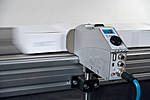Today’s dynamic packaging market poses significant challenges for industry suppliers, not least the demand for a reduction in packaging materials, the introduction of more eco-friendly packaging products and a growing trend towards product tracking and traceability.
Packaging – More or Less ?
Whilst demand for packaging is strong in many of the developing countries, across the industrialised markets, packaging penetration rates are near saturation point. Here, the industry is under siege from overcapacity and environmental concerns associated with waste and excess packaging. Therefore, whilst three quarters of the world wants more packaging, a quarter of the world is demanding less. Consumer preferences are shifting towards more eco friendly products and green packaging solutions. With major retailers beginning to demand more sustainable packaging, now is the time to look closely at greener solutions.
The Weber group of companies take a green packaging life cycle approach, working closely with both machinery and material suppliers. This approach looks at packaging from production to distribution, through to the end of the packaging life cycle. Today, machinery manufacturers strive to produce equipment that runs more efficiently and uses less energy. Many new packaging machines are being built to accommodate the wide range of new biodegradable packaging materials. For their part, materials suppliers are producing more eco friendly and bio degradable products and inventing entire packaging solutions in conjunction with equipment manufacturers that use less material, glue and energy to produce products with a greatly reduced carbon foot print.
Trends in labelling
The developments in packaging and materials are mirrored by other significant changes within the marketplace. There is a growing trend towards shorter and more varied print runs, an increasing demand for personalisation, plus traceability and validation especially within the pharmaceutical sector.
 This, together with a move towards seasonal and time sensitive labels, regionally focused products and multiple SKU entries has boosted the introduction of digital printing technology. Although running 76 flexographic presses across its 5 worldwide converting operations, Weber has also invested heavily in digital printing technology.
This, together with a move towards seasonal and time sensitive labels, regionally focused products and multiple SKU entries has boosted the introduction of digital printing technology. Although running 76 flexographic presses across its 5 worldwide converting operations, Weber has also invested heavily in digital printing technology. The ability to produce shorter runs has reduced Weber’s customer’s inventory and costs. Digital technology also enables the production of labels for customers who require just enough labels to test new products in the marketplace.
(Weber produces labels using both flexographic and digital technology)
Product identification and verification
Pharmaceutical labelling is increasingly complex, with pressure from consumers and regulatory bodies to prevent counterfeiting and improve safety. Manufacturers and packaging companies must ensure products can be recognized and verified quickly and easily throughout the supply chain. To achieve this, a more sophisticated labelling system than the EAN barcode — the current retail labelling standard — is needed for the pharmaceutical sector.
During the last 30 years, conventional barcodes have revolutionized labelling. By today's standards, however, they offer limited capacity for data handling. For example, where thousands of individual product packs carry the same barcode, it is impossible to check if a barcode has been copied and used on counterfeit goods, or if products are destined for different markets. Furthermore, EAN barcodes provide no capacity for batch or shipment specific data.
By comparison, the 2D code format offers higher data densities. A matrix code is made up of a pattern of cells that can be square, hexagonal, or circular. Data is encoded via the relative positions of these light and dark areas, and encoding schemes use error detection and correction techniques to improve reliability and reading of partially damaged symbols. The 2D code format can be used to identify individual products and as a scannable symbol on packages and cartons.
Applying RFID inlays to pressure sensitive labels is another growing trend and Weber has been actively involved in this market for the last 4 years. Extensive quality procedures and 100% checks on the antenna and chip ensure that no defective inlays make it as far as the printer encoder or applicator. The use of RFID inlays allows customers to track product data throughout the supply chain ensuring reliable and accurate data management.
(Weber 5300 RFID print & apply system)
Working on the outside of the box
In the current climate, manufacturers are seeking every opportunity to reduce costs. Using high volumes of pre-printed boxes or cartons, for some is now seen as an unnecessary expenditure. Replacing these with plain boxes and using the latest high-resolution direct-to-case ink-jet coding equipment, packaging companies can make significant savings whilst helping the environment.
(Weber - direct-to-case ink-jet coding)
For the forseeable future, the global packaging market looks set to undergo further significant changes which will be driven by technology and the ongoing need to consider the environmental impacts of packaging. Weber’s pedigree, together with its ongoing philosophy of innovation, product development and commitment to sustainability, will ensure that the company not only survives today’s challenges, but will remain as a leading supplier of labels and labelling systems.
Chris Semple is a labelling consultant with Weber Marking Systems


